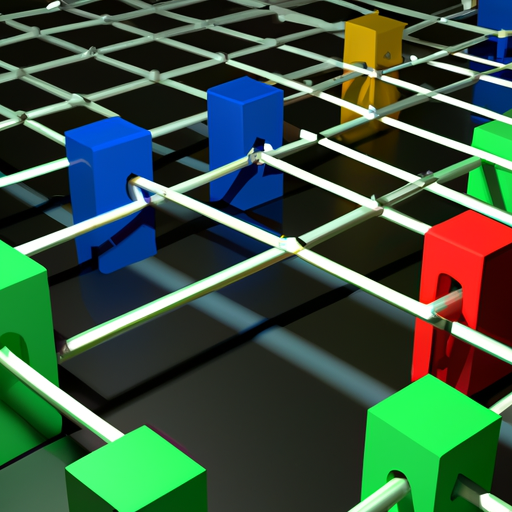In today’s rapidly evolving digital landscape, trust is a valuable currency. As we navigate through a world where information and transactions are conducted online, it becomes increasingly important to ensure the integrity and security of our digital interactions. Enter blockchain technology – a revolutionary concept that promises to transform the way we verify, authenticate, and trust in the digital realm. In this article, we will decode blockchain and unravel its building blocks to understand its potential in shaping a trustworthy future. From understanding the basics of blockchain to exploring its power beyond cryptocurrency, we will delve into the mechanics and potential of this groundbreaking technology. Join us as we uncover the secrets behind cryptocurrency and how blockchain technology is revolutionizing trust in the digital world.
- 1. Understanding Blockchain Basics: Decoding the Fundamentals of a Trustworthy Future
- 2. Unraveling the Building Blocks of Blockchain: A Comprehensive Guide to Decoding its Mechanics
- 3. The Power of Blockchain: Exploring its Potential Beyond Cryptocurrency
- 4. Behind Cryptocurrency: How Blockchain Technology is Revolutionizing Trust in the Digital World
1. Understanding Blockchain Basics: Decoding the Fundamentals of a Trustworthy Future
Blockchain technology has gained significant attention in recent years, thanks to its potential to revolutionize various industries. From finance to supply chain management, blockchain offers a secure and transparent way to record and verify transactions. However, understanding the basics of this complex technology can be overwhelming. In this section, we will decode the fundamentals of blockchain and explore how it can shape a trustworthy future.
At its core, blockchain is a decentralized digital ledger that records transactions across multiple computers or nodes. Each transaction is grouped into a block and added to a chain of previous blocks, creating a permanent and immutable record. This decentralized nature eliminates the need for a central authority, such as a bank or government, to validate and authorize transactions. Instead, the network of nodes collaboratively verifies and approves each transaction, ensuring transparency and trust.
One of the key features of blockchain is its ability to provide security through cryptography. Each transaction is encrypted and linked to the previous block using a unique mathematical algorithm. This ensures that once a block is added to the chain, it becomes nearly impossible to alter or tamper with the data. This immutability makes blockchain an ideal solution for industries where trust is crucial, such as finance and healthcare.
Decoding blockchain also involves understanding its relationship with cryptocurrencies like Bitcoin. Bitcoin was the first successful implementation of blockchain technology, and it remains one of the most widely known applications. Blockchain provides the underlying technology that enables the secure and transparent transfer of digital currencies. However, blockchain is not limited to cryptocurrencies alone. Its potential applications extend far beyond the realm of digital money.
Blockchain has the potential to revolutionize various industries by enhancing transparency, reducing fraud, and improving efficiency. For example, in supply chain management, blockchain can track and verify the movement of goods from their origin to the end consumer. This eliminates the possibility of counterfeit products entering the market and ensures ethical sourcing.
In conclusion, understanding the basics of blockchain is essential for unraveling the building blocks of a trustworthy future. Its decentralized nature, cryptographic security, and potential applications in various industries make it a powerful tool for the modern age. By decoding blockchain, we can embrace its potential and unlock new possibilities for a more transparent and secure world.
Keywords: decoding blockchain, blockchain basics, behind cryptocurrency.
2. Unraveling the Building Blocks of Blockchain: A Comprehensive Guide to Decoding its Mechanics
Blockchain technology is often hailed as a revolutionary force that has the potential to reshape various industries and transform the way we conduct transactions. However, understanding the mechanics behind blockchain and its building blocks is crucial in order to grasp its full potential and harness its power effectively.
At its core, blockchain is a decentralized, distributed ledger that records and verifies transactions across multiple computers or nodes. This allows for a transparent and secure system that eliminates the need for intermediaries or third parties. But how does it all work?
To decode the mechanics of blockchain, let’s start with the basic building blocks. The first building block is the block itself, which contains a list of transactions. These transactions are grouped together and added to the blockchain in a chronological order.
Each block is linked to the previous block through a cryptographic hash function. This creates a chain of blocks, hence the name blockchain. The hash function is like a unique digital fingerprint that ensures the integrity and immutability of the data stored in the block.
The second building block is the consensus mechanism. In a decentralized network, where there is no central authority, a consensus mechanism is needed to agree on the validity of transactions and ensure the integrity of the blockchain. This is achieved through various consensus algorithms such as Proof of Work (PoW) or Proof of Stake (PoS).
In PoW, miners compete to solve complex mathematical puzzles to validate transactions and add them to the blockchain. The miner who successfully solves the puzzle is rewarded with cryptocurrency. PoS, on the other hand, relies on the ownership of a certain amount of cryptocurrency to validate transactions and create new blocks.
Another important building block is the distributed network. Blockchain relies on a network of computers or nodes that collectively maintain and validate the blockchain. This distributed nature ensures that no single entity has control over the entire network, making it resistant to censorship and tampering.
Finally, cryptography plays a vital role in the security of blockchain. It ensures that transactions are secure and private, and that only authorized participants can access and modify the blockchain. Cryptographic techniques such as digital signatures and public-private key pairs are used to authenticate and verify transactions.
Understanding the building blocks of blockchain is essential to fully grasp its potential and implications. By decoding blockchain and unraveling its mechanics, we can begin to appreciate its significance in revolutionizing industries beyond just cryptocurrency. It lays the foundation for a trustworthy future where transparency, security, and decentralization are at the forefront.
3. The Power of Blockchain: Exploring its Potential Beyond Cryptocurrency
Blockchain technology has gained significant attention in recent years, primarily due to its association with cryptocurrencies like Bitcoin. However, the potential of blockchain extends far beyond just digital currencies. In this section, we will explore the power of blockchain and its potential applications beyond cryptocurrency.
One of the key features of blockchain is its ability to provide a secure and transparent way of recording and verifying transactions. This has the potential to revolutionize various industries by eliminating the need for intermediaries and increasing efficiency. For example, in supply chain management, blockchain can be used to track the movement of goods from the manufacturer to the end consumer, ensuring transparency and reducing the risk of fraud or tampering.
Blockchain also has the potential to transform the healthcare industry. By securely storing and sharing patient data, blockchain can improve interoperability, reduce medical errors, and enhance patient privacy. Additionally, it can enable the development of decentralized health records, giving patients full control over their personal health information.
Another area where blockchain shows immense potential is in the field of voting and elections. With its ability to provide an immutable and transparent ledger, blockchain can help to eliminate voter fraud and ensure the integrity of the electoral process. By recording each vote on a blockchain, it becomes nearly impossible to tamper with or manipulate the results, thus increasing trust and confidence in the democratic system.
Furthermore, blockchain technology has the potential to revolutionize the energy sector. By enabling the creation of peer-to-peer energy trading platforms, blockchain can allow individuals and businesses to directly buy and sell excess renewable energy, promoting sustainability and decentralization of the energy grid.
The potential applications of blockchain technology are vast and diverse. From supply chain management to healthcare, voting systems to energy trading, blockchain has the power to transform traditional industries and create a more trustworthy and efficient future. As we continue to decode the building blocks of blockchain, it becomes evident that its potential extends far beyond cryptocurrency and into numerous aspects of our daily lives.
4. Behind Cryptocurrency: How Blockchain Technology is Revolutionizing Trust in the Digital World
Blockchain technology has emerged as a transformative force, revolutionizing trust in the digital world. At the heart of this revolution is the concept of decentralization, which forms the foundation of blockchain’s trustworthiness. Unlike traditional centralized systems, blockchain operates on a distributed network of computers, known as nodes, that collectively maintain and validate transactions. This decentralized nature eliminates the need for a central authority, such as a bank or government, to oversee and verify transactions.
One of the key applications of blockchain technology is cryptocurrency. Cryptocurrencies, like Bitcoin, are digital assets that utilize blockchain technology to facilitate secure and transparent transactions. Behind the scenes, blockchain technology ensures the integrity and immutability of cryptocurrency transactions, making it virtually impossible to manipulate or counterfeit.
The process of recording cryptocurrency transactions on the blockchain involves a series of steps. First, a transaction request is initiated by the sender, which includes the recipient’s public key and the amount being transferred. This transaction request is then broadcasted to the network of nodes for verification.
The verification process, known as mining, involves solving complex mathematical puzzles to validate the transaction and add it to a block. Miners compete against each other to solve these puzzles, with the winner earning the right to add the block to the blockchain. This process ensures that only valid transactions are added to the blockchain, maintaining the integrity and security of the system.
Once a block is added to the blockchain, it becomes a permanent and transparent record of the transaction. This transparency is a fundamental aspect of blockchain technology, as it allows anyone to view and verify transactions. This feature not only enhances trust but also enables greater accountability and reduces the risk of fraud.
Moreover, blockchain technology also provides enhanced security through cryptographic techniques. Each transaction on the blockchain is encrypted and linked to the previous transaction, creating a chain of blocks that are virtually tamper-proof. This makes blockchain technology highly resistant to hacking and fraud, providing a secure platform for digital transactions.
Blockchain’s impact goes beyond just cryptocurrencies. Its decentralized and transparent nature has the potential to transform various industries, such as supply chain management, healthcare, finance, and more. By providing a decentralized and trustworthy platform, blockchain technology has the power to revolutionize the way we transact and interact in the digital world.
In conclusion, blockchain technology has become the backbone of trust in the digital world. By decentralizing transactions, ensuring transparency, and leveraging cryptographic techniques, blockchain technology has revolutionized trust in the realm of cryptocurrencies and beyond. As we continue to decode the intricacies of blockchain and understand its basics, the potential for a trustworthy future powered by this technology becomes increasingly evident.
In conclusion, decoding blockchain is essential in unraveling the building blocks of a trustworthy future. Understanding the fundamentals of blockchain technology, its mechanics, and its potential beyond cryptocurrency is crucial for individuals and businesses alike. As we have explored in this article, blockchain has the power to revolutionize trust in the digital world, providing security, transparency, and efficiency. By grasping the basics of blockchain and delving into its intricacies, we can unlock its full potential and pave the way for a more trustworthy and decentralized future. So, let us continue to decode blockchain, embrace its power, and harness its capabilities for a better tomorrow.








No Comment! Be the first one.